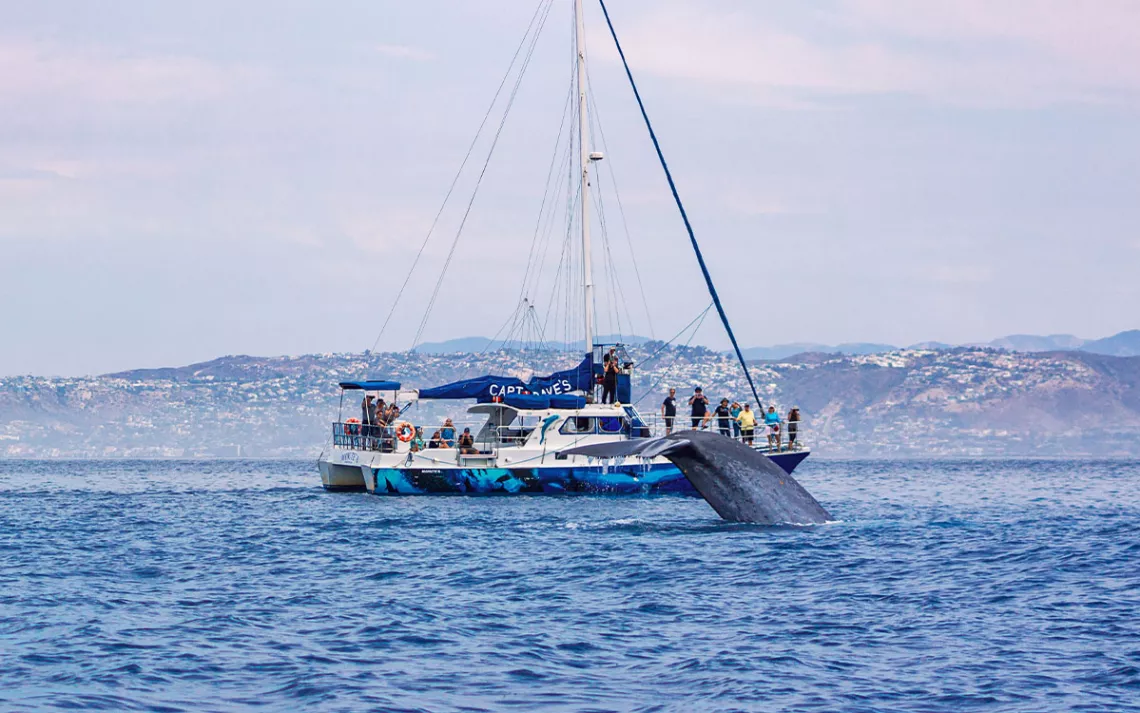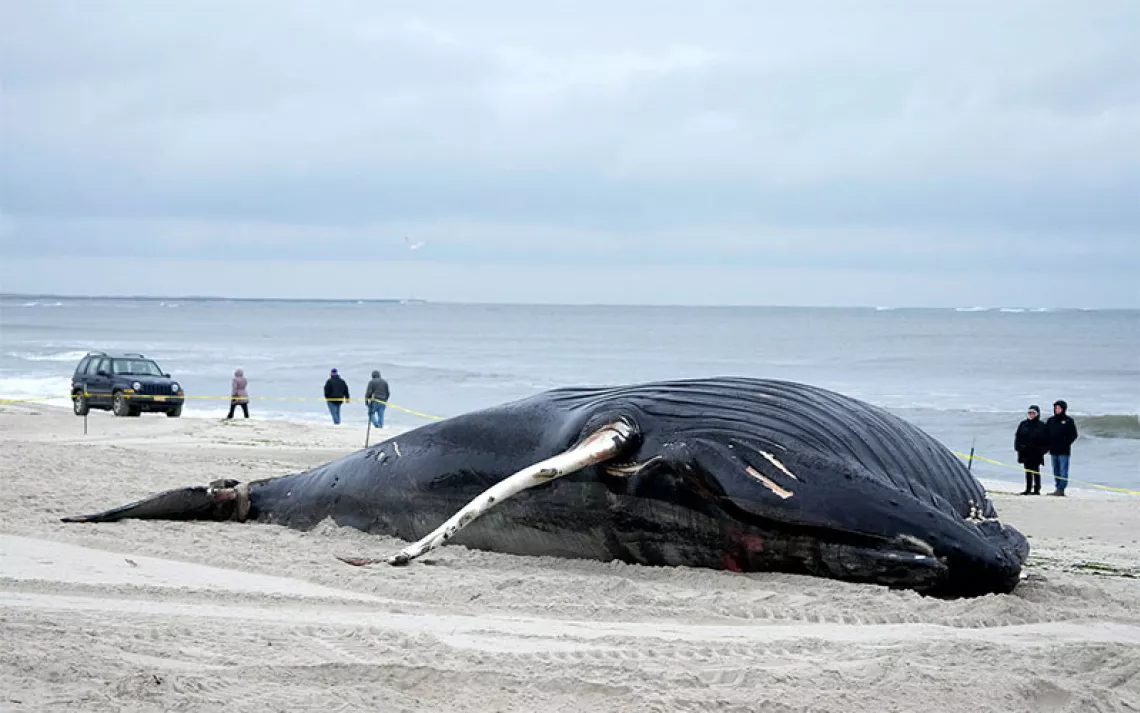ENVIRONMENT EXPLAINED
How to Whale Watch Respectfully
Whale watching is less about getting that perfect view and more about learning, connection, and reciprocity

Photo by Christina McMahon-Foley
Who doesn't want to see a whale? For discriminating viewers coast to coast, there's nothing bigger, splashier, or more worth watching. Whale tour companies carry millions of people onto the water every year, nearly half of them in North America, where whale fever hits seasonally in different places: New England and Alaska in the summer, the Southeast and Northwest in the fall and winter, and Southern California all year round.
But whales are not really tourist attractions. They're beings in their own right—singing their songs, caring for their families and communities, and bolstering whole marine ecosystems as they feed, migrate, and churn up the water column. When you go out to watch them live these rich lives, you're a guest in their home.
Thirty years ago, even if whale watch operators personally respected whales, running a business led them to view the animals as "a commodity," said Christina McMahon Foley, senior naturalist and educational coordinator for Cape Ann Whale Watch in Massachusetts. Increasingly, though, companies consider respect for whales a vital part of their jobs, above and beyond the general legal requirements laid out by the Endangered Species Act (which limits how close you can be to certain species), and the Marine Mammal Protection Act (which prohibits harassment). Visitors can do their part too. Here's some etiquette to keep in mind as you contemplate dropping in on whales.
Choose how you cruise
Fast, loud, and nosy watercraft can easily stress out whales. Different federal and state laws set some limits around boat speed and viewing distances, especially in protected waters. But at least two organizations, the World Cetacean Alliance (WCA) and Whale SENSE, have established more specific best practices. Companies committed to responsible whale watching behavior can choose to get certified by these organizations and added to lists that can be handy for guests trying to decide among tour operators.

Photo courtesy Jess Wright/Capt. Dave's Dolphin & Whale Watching Safari
Companies on the Whale SENSE list—which covers Alaska and the North American Atlantic and is administered by NOAA Fisheries, Whale and Dolphin Conservation, and Stellwagen Bank Marine Sanctuary—promise to educate their passengers, report and stand by injured whales, and follow specific whale approach protocols, including coordinating viewing time with other vessels and never approaching whales from the front. They commit to one stewardship project per year, such as a beach clean-up or public presentation, and undergo annual trainings and an on-the-water evaluation.
Whale watching companies on the WCA Certified list, which is global, follow a more comprehensive list of rules, which prohibit noise and litter, and dictate how to approach and spend time near the animals. WCA Certified companies also commit themselves to holding community events, showcasing new research, and reducing energy use, pollution, and waste. If there are no certified operators near you, "look for reviews where people describe the operators as respectful," said Gisele Anderson, vice president of Captain Dave's Dolphin & Whale Watching Safari in Dana Point, California. (Captain Dave's and Cape Ann Whale Watch are both WCA certified.)
If you'd rather not risk disturbing whales at all, you may be able to watch them from land. The Pacific coast Whale Trail links up more than 100 sites where you can see marine mammals from shore, from Prince Rupert, British Columbia down through California's Dana Point Headlands. Similar hot spots exist in other regions. Use iNaturalist to virtually cruise the shoreline and see where people have been spotting humpbacks, bottlenose dolphins, or other common species.
Let go of expectations
We're living in a golden age of animal media, able to see spectacular humpback breaches or splashy lobtailing with the click of a mouse. Whale watching companies often also highlight such moments in their marketing materials.
Because of this, guests may come onto a whale watching boat with certain expectations about how close they might get to the animals, or dramatic behaviors they might see. This can cut against the approach of responsible tour operators, who are focused on not interrupting whales and dolphins for the sake of good viewing, and instead "respecting whatever it is that they're doing," whether that's socializing, feeding, or nursing, Anderson said.
Tour operators work hard to manage expectations and to explain why, for instance, they're not chasing down that mom and calf. But it's worth it to check in with yourself and your group ahead of time to make sure you're coming in ready for a real experience, rather than a camera-ready one. "We're not here to get a show," McMahon Foley said.
This is not necessarily a sacrifice. The encounters that result from a responsible approach can be particularly special, Anderson said. Like humans, whales tend to be quite curious. Letting them make their own decisions creates the conditions for a mutual experience, in which people decide to whale watch and whales decide to people watch. Using these practices, Anderson and her colleagues and passengers have found themselves eye to eye with fin whales and in the middle of dolphin stampedes. "There's nothing more exhilarating than giving them space and then having them choose to come to you," she said.
Get your (scientific) feet wet
Even brand-new whale watchers can be more than passive observers. Because whale watching boats spend so much time out on the water, they can "serve as platforms of opportunity for the collection of data that can be used to better understand and protect whale and dolphin populations," according to the International Whaling Commission's Whale Watching Handbook. In 2000, a literature review found that dozens of peer-reviewed whale studies relied on data collected from tourism vessels. Observations from tourists specifically have helped researchers track Eastern Pacific orca offshore in Alaska and understand the growing humpback population near New York City.
If the boat you're on isn't enrolled in a study program, you can still help gather knowledge. A recent community science initiative, Happywhale, collects whale photos from anyone who submits them, uses markings to identify known individual whales, and collates the observations to track whale movements around the world. This provides a "bigger, broader perspective of where these whales are being seen," said McMahon Foley.
Don't just watch
Inserting yourself into a wild animal's day always comes with a risk of disturbing them. For whale watching guides, this trade-off is most worth it if guests leave their boat with a new perspective, and perhaps some new habits. "Maybe they don't use as much plastic, [or] never use Styrofoam again," or give up net-caught seafood, said Anderson. (Entanglement in fishing gear kills many whales every year.)
McMahon Foley encourages guests to be as present as possible on the boat, turning off their phones and enjoying the rare chance to inhabit a different world. "I want them to use their senses," she said, and "to walk off and just think twice about how they interact with their natural environment." A whale watch is a chance to listen, smell, and feel—and then to act.
 The Magazine of The Sierra Club
The Magazine of The Sierra Club



